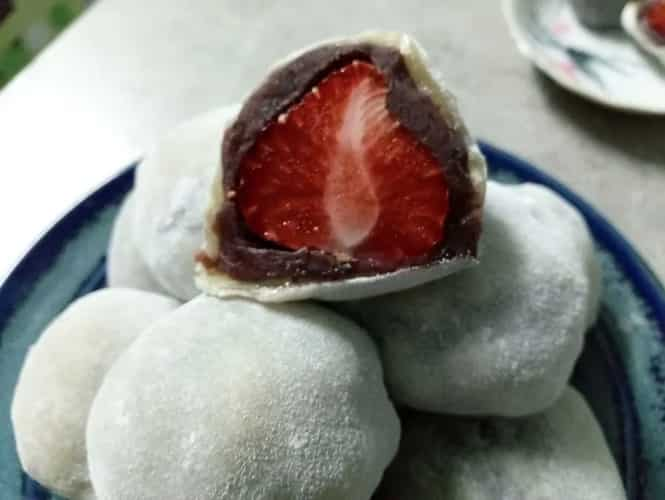Mochi, a beloved staple in Japanese cuisine, boasts a rich history and cultural resonance. With origins tracing back over a millennium, mochi has evolved from a ceremonial food to a versatile culinary delight. Crafted from glutinous rice pounded into a sticky, elastic form, its preparation symbolises unity and togetherness as communities gather to pound the rice during festivals like New Year's.
Mochi's significance extends to various celebrations, including weddings and ancestral rites. Its chewy texture and sweet or savoury fillings reflect the delicate balance of flavours in Japanese gastronomy. Mochi's enduring presence in both traditional rituals and modern delicacies highlights its enduring role as a symbol of culture, connection, and culinary innovation.
Traditional Mochi Varieties
Red Bean Paste (Anko): Anko, a revered filling, features sweet, velvety red bean paste. Crafted from azuki beans, it balances earthy richness with a hint of sweetness, embodying traditional Japanese flavours.
Sesame Mochi: Infused with sesame, this variation offers a delightful nuttiness. The fragrant sesame paste harmonises with the chewy mochi, creating a fusion of textures and tastes.
Kinako (Roasted Soybean Flour) Mochi: Coated in kinako, mochi gains a delicate, toasty essence. The roasted soybean flour lends a subtle sweetness and unique aroma, enhancing the mochi's overall experience.

Mochi's allure goes beyond taste, encompassing a spectrum of captivating textures that elevate the dining experience. The hallmark of chewy mochi rests in its pliant resilience, requiring deliberate bites that engage the senses. Contrastingly, softer iterations yield to the gentlest pressure, dissolving almost effortlessly on the palate. Chewiness prolongs the interaction, amplifying flavours, while softer mochi offers a fleeting, ethereal quality. The balance of tactile engagement and fleeting delicacy exemplifies the duality of Japanese aesthetics, encapsulating a harmonious relationship between gustatory pleasure and tactile sensation, ultimately making mochi an artful masterpiece in both flavour and texture.
Mochi's evolving landscape includes options that accommodate diverse dietary needs. Gluten-free mochi, crafted from alternative flours like rice or glutinous rice, caters to those with gluten sensitivities. Vegan mochi, ingeniously replacing animal-derived ingredients with plant-based alternatives, opens its indulgence to a broader audience. Despite its indulgent reputation, mochi has nutritional value.
Its core ingredient, glutinous rice, is a good source of carbohydrates and provides a steady energy release. Mochi's moderate calorie content suits mindful consumption, aligning with a balanced diet. While its sugar content may vary with fillings, it can be enjoyed in moderation. As a culturally cherished treat, mochi offers a harmonious union of tradition and adaptability to modern dietary preferences.
5 Tips To Make The Perfect Mochi At Home
1. Rice Selection: Opt for glutinous rice, also known as sweet or sticky rice, which is crucial for mochi's signature chewy texture.
2. Proper Steaming: Steam rice until tender and fully cooked. This ensures the grains are soft and cohesive for easy pounding.
3. Precise Pounding: Gradually pound steamed rice to achieve a smooth, elastic consistency. Avoid over-pounding, which can lead to toughness.
4. Filling Balance: Incorporate balanced fillings like anko (red bean paste) or fresh fruits, ensuring they harmonise with the mochi's taste and texture.
5. Dusting and Storage: Dust hands and surfaces with starch to prevent sticking. Store mochi in an airtight container to maintain freshness and prevent drying. Enjoy it within a few days for the best experience.
Recipe For Traditional Mochi
Video Credits: Joshua Weissman/YouTube
Ingredients:
2 cups glutinous rice (sweet rice)
1 3/4 cups of water
Cornflour or potato starch, for dusting
Filling of your choice (e.g., red bean paste, sweetened chestnut, etc.)
Instructions:
Prepare the Rice:
Rinse the glutinous rice in cold water until the water runs clear. Drain well.
In a rice cooker or a large pot, combine the rinsed rice and water. Allow it to soak for 30 minutes.
Cook the Rice:
Cook the rice according to your rice cooker's instructions or on the stovetop. Once cooked, fluff the rice and let it cool slightly.
Pounding the Rice:
Traditionally, mochi is pounded using a wooden mallet and mortar called an "usu." If available, follow the pounding method carefully.
Alternatively, use a stand mixer with a paddle attachment. Add the cooked rice and mix on low speed until the rice becomes sticky and elastic, about 10–15 minutes.
Shaping the Mochi:
Dust a clean surface or a wooden mochi board with cornflour or potato starch.
Scoop a small portion of the sticky rice and flatten it into a circle or rectangle.
Place a small amount of your chosen filling in the centre, and fold the rice over to encase the filling. Pinch the edges to seal.
Dusting and Serving:
Roll the mochi in more starch to prevent sticking.
Serve immediately or store in an airtight container at room temperature. Consume within a day or two for the best texture.
Notes:
Be cautious when working with mochi, as it can be very sticky. Keep your hands and work surface well-dusted with starch.
Experiment with different fillings like red bean paste, sweetened chestnuts, or fresh fruit.
Traditional mochi is usually consumed on the day it's made. If you need to store it, keep it in an airtight container to prevent it from drying out.
Enjoy the delightful and authentic taste of homemade traditional mochi!


